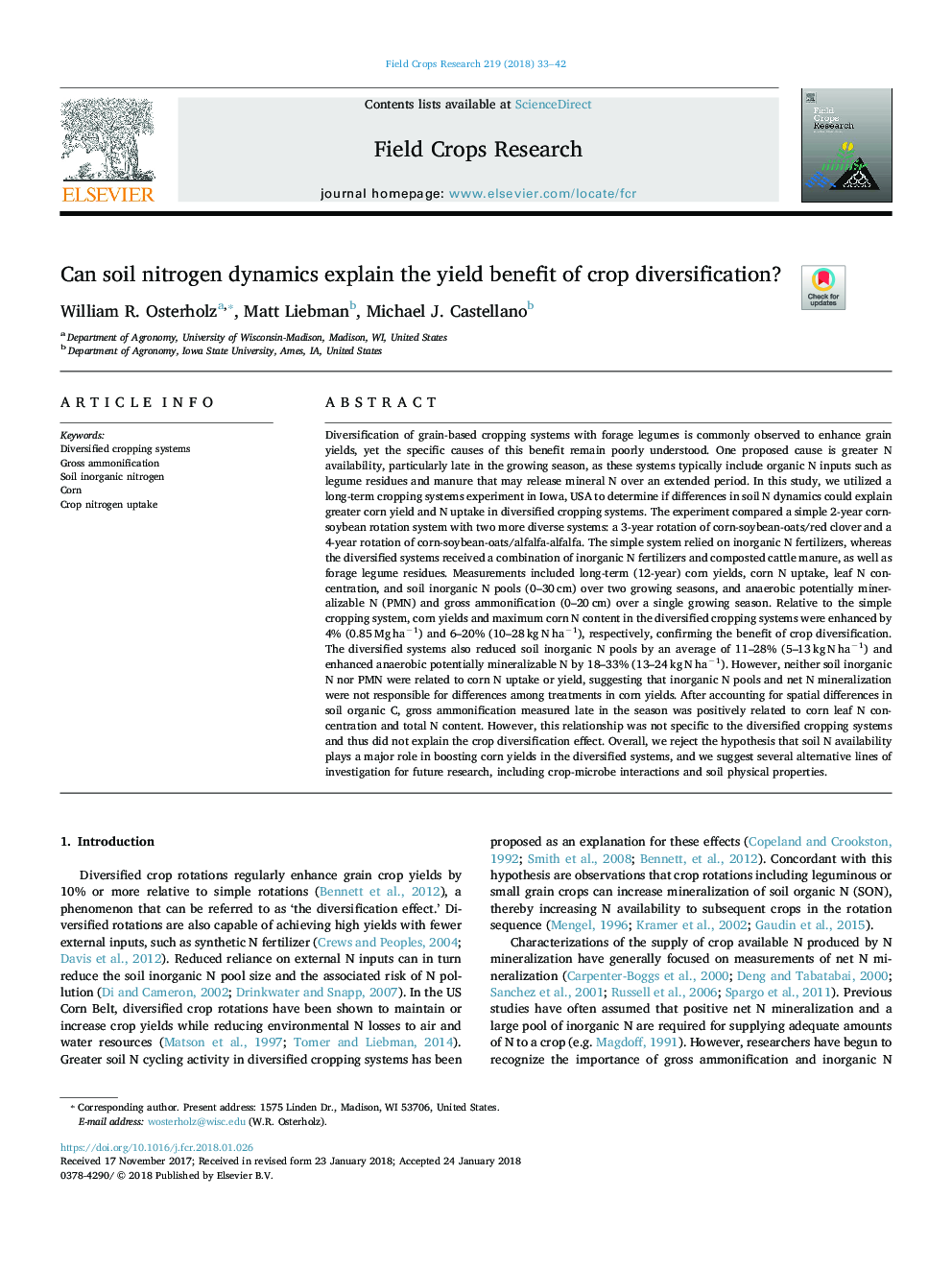| کد مقاله | کد نشریه | سال انتشار | مقاله انگلیسی | نسخه تمام متن |
|---|---|---|---|---|
| 8879306 | 1624644 | 2018 | 10 صفحه PDF | دانلود رایگان |
عنوان انگلیسی مقاله ISI
Can soil nitrogen dynamics explain the yield benefit of crop diversification?
ترجمه فارسی عنوان
آیا پودر نیتروژن خاک میتواند مزایای عملکرد محصول تنوع را توضیح
دانلود مقاله + سفارش ترجمه
دانلود مقاله ISI انگلیسی
رایگان برای ایرانیان
کلمات کلیدی
سیستم های مختلف گندم، آمونیاک ناخالص، نیتروژن معدنی خاک، ذرت، جذب نیتروژن محصول،
موضوعات مرتبط
علوم زیستی و بیوفناوری
علوم کشاورزی و بیولوژیک
علوم زراعت و اصلاح نباتات
چکیده انگلیسی
Diversification of grain-based cropping systems with forage legumes is commonly observed to enhance grain yields, yet the specific causes of this benefit remain poorly understood. One proposed cause is greater N availability, particularly late in the growing season, as these systems typically include organic N inputs such as legume residues and manure that may release mineral N over an extended period. In this study, we utilized a long-term cropping systems experiment in Iowa, USA to determine if differences in soil N dynamics could explain greater corn yield and N uptake in diversified cropping systems. The experiment compared a simple 2-year corn-soybean rotation system with two more diverse systems: a 3-year rotation of corn-soybean-oats/red clover and a 4-year rotation of corn-soybean-oats/alfalfa-alfalfa. The simple system relied on inorganic N fertilizers, whereas the diversified systems received a combination of inorganic N fertilizers and composted cattle manure, as well as forage legume residues. Measurements included long-term (12-year) corn yields, corn N uptake, leaf N concentration, and soil inorganic N pools (0-30â¯cm) over two growing seasons, and anaerobic potentially mineralizable N (PMN) and gross ammonification (0-20â¯cm) over a single growing season. Relative to the simple cropping system, corn yields and maximum corn N content in the diversified cropping systems were enhanced by 4% (0.85â¯Mgâ¯haâ1) and 6-20% (10-28â¯kgâ¯Nâ¯haâ1), respectively, confirming the benefit of crop diversification. The diversified systems also reduced soil inorganic N pools by an average of 11-28% (5-13â¯kgâ¯Nâ¯haâ1) and enhanced anaerobic potentially mineralizable N by 18-33% (13-24â¯kgâ¯Nâ¯haâ1). However, neither soil inorganic N nor PMN were related to corn N uptake or yield, suggesting that inorganic N pools and net N mineralization were not responsible for differences among treatments in corn yields. After accounting for spatial differences in soil organic C, gross ammonification measured late in the season was positively related to corn leaf N concentration and total N content. However, this relationship was not specific to the diversified cropping systems and thus did not explain the crop diversification effect. Overall, we reject the hypothesis that soil N availability plays a major role in boosting corn yields in the diversified systems, and we suggest several alternative lines of investigation for future research, including crop-microbe interactions and soil physical properties.
ناشر
Database: Elsevier - ScienceDirect (ساینس دایرکت)
Journal: Field Crops Research - Volume 219, 15 April 2018, Pages 33-42
Journal: Field Crops Research - Volume 219, 15 April 2018, Pages 33-42
نویسندگان
William R. Osterholz, Matt Liebman, Michael J. Castellano,
